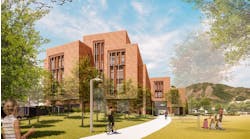The University of California, Berkeley, says it has reduced its carbon footprint to 1990 levels—two years ahead of the goal it set in 2007.
The university’s greenhouse gas emissions, as measured in 2012, reached 1990 levels by investing in energy efficiency and sustainable transportation practices; buying greener power (such as solar and wind), and improving the accuracy of its data gathering.
“Climate change is an existential global threat,” UC Berkeley Chancellor Nicholas Dirks says in a news release, “and one that the UC Berkeley community is continually addressing through campus practices, teaching, research and public service.”
The university’s drop in emissions also puts it eight years ahead of meeting University of California Sustainable Practices Policy guidelines, as well as the levels established in the state’s Global Solutions Warming Act of 2006. Those call for decreasing greenhouse gas emissions to 1990 levels by 2020.
Dirks plans to set a revised 2020 goal for further reduction of the campus carbon footprint.
“My intention is to establish a new target that will take us further below 1990 levels,” he says. “That will establish a challenging, but achievable, goal for the year 2020, on our path to climate neutrality for the entire campus.”
Student initiatives, such as an annual energy symposium and energy-saving competitions among residence halls, have contributed to campus carbon-cutting solutions, says Kira Stoll, UC Berkeley’s sustainability manager.
Some of the energy-efficiency projects carried out on the Berkeley campus: installation of new lighting in most buildings; upgrades to heating, ventilation and air conditioning systems; and continuous tracking of energy data to ensure systems are running properly.
The university says it also has completed 11 LEED-certified green building projects, which represent almost 7 percent of the campus’s total square footage. In addition, all major construction projects in the planning and design phase are expected to be LEED-certified.
Since 2008, the Green Initiative Fund — a student-funded grant program — has awarded $1.5 million to nearly 200 sustainability projects that have improved energy and water efficiency, restored habitat and reduced waste.
Reducing the use of fuel on campus has provided substantial savings, the university says. UC Berkeley has been eliminating older, less efficient vehicles and replacing them with hybrids and alternative fuel vehicles. More student housing is within walking distance of campus, and when students move out of the residence halls and into other housing, many choose to live near campus or within a bus ride away.
“Of our commuters, 83 percent now walk, bicycle, rideshare or take public transit,” says Stoll.

